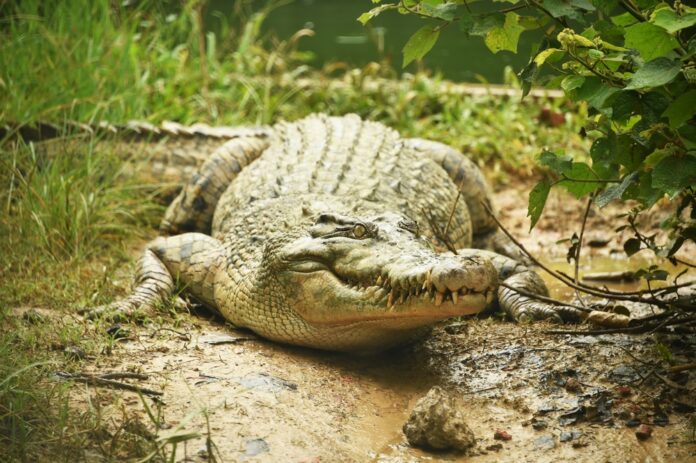When you look at a crocodile, it’s easy to feel like you’re staring into the distant past. These ancient-looking reptiles, with their scaly skin and fearsome teeth, seem like living fossils — creatures frozen in time, unchanged for millions of years.
But despite their prehistoric appearance, animals like crocodiles are not truly evolutionary relics. In fact, they’ve been evolving all along, just not in ways that are immediately obvious.
The Illusion of Living Fossils
The concept of living fossils has long fascinated scientists and laypeople alike. It describes organisms that appear remarkably similar to their ancient ancestors in the fossil record. The term suggests a lack of significant evolutionary change, giving the impression that these creatures have somehow bypassed the forces of natural selection.
However, this notion is more myth than reality. Evolution is an ongoing process, and even seemingly unchanged species are constantly adapting to their environments — albeit in sometimes nearly invisible ways.
Read More: What Are Fossils and Where Are They Found the Most?
1. Crocodiles: Masters of Subtle Adaptation
(Credit: salimreza1989/Shutterstock)
Crocodiles are often cited as quintessential examples of living fossils. Their ancestors first appeared around 200 million years ago during the Late Triassic and Early Jurassic periods, and the modern crocodiles we know today are strikingly similar in appearance to their ancient ancestors. But to say that crocodiles haven’t really evolved isn’t really true.
Research shows that crocodiles have undergone significant evolutionary changes over millions of years, including developing their very strong immune systems. Their evolved ability to slow their metabolism and survive for extended periods without food was another major adaptation, enabling them to outlast competitors when scarcity strikes.
Read More: First Ancient Crocodile Relative from 237 Million Years Ago Was Unearthed in Brazil
2. Horseshoe Crabs: The Ancient Survivors
(Credit: RAJIB RAIHAN/Shutterstock)
Another frequently mentioned living fossil is the horseshoe crab, which has existed in some form for around 450 million years. With their hard exoskeletons and spiky tails, horseshoe crabs look like something that crawled out of a prehistoric ocean. Yet, like crocodiles, they have not remained entirely static.
Despite looking superficially similar to their ancient ancestors, horseshoe crabs have evolved over the past several hundred million years in response to changing environmental and oceanic conditions.
Furthermore, the evolution of their blue blood, which is highly sensitive to toxic bacteria, has helped them persistently survive in hazardous environments where other species might perish over time. (This blood, which contains a substance called Limulus Amebocyte Lysate (LAL), has even found use in modern medicine, as it’s widely used for detecting bacterial contamination in vaccines and medical devices.)
Read More: 5 Ancient Animals That Stood The Test Of Time
3. The Nautilus: A Master of Evolutionary Efficiency
(Credit: agsaz/Shutterstock)
The nautilus, with its beautifully spiraled shell, is often described as a living fossil. They are the modern descendants of nautiloids, which date back to the Cambrian explosion some 500 million years ago.
The nautilus has evolved to be a highly efficient predator in its deep-sea habitat, with adaptations such as buoyancy control via gas-filled chambers in its shell, which allow it to float and sink with minimal energy use. Moreover, the nautilus’ slow metabolism and long lifespan — which can be up to 20 years or more — are traits that it has evolved to suit its niche, allowing it to thrive where other species might struggle over time.
Read More: 5 New Animal Species Discovered in 2023
4. Coelacanths: The Rediscovered Fossil Fish
(Credit:iPlantsman/Shutterstock)
Perhaps no other creature embodies the idea of a living fossil better than the coelacanth. This deep-sea fish was thought to have gone extinct some 70 million years ago until a living specimen was caught off the coast of South Africa in 1938. The coelacanth’s lobed fins and primitive features seemed like a direct link to the Devonian period some 400 million years ago.
But despite its ancient appearance, the coelacanth has been evolving over the past several hundred million years — and even much more recently than that. For instance, in 2021, researchers discovered that approximately 10 million years ago, the African coelacanth acquired 62 new genes through interactions with other species. However, past genetic studies also indicated that coelacanth genes have indeed been evolving more slowly than the genes of most other organisms.
Read More: These 5 Giant Animals Walked Alongside Ancient Humans
Evolution Never Sleeps
The idea that some animals have remained entirely unchanged for hundreds of millions of years is compelling, but it doesn’t really hold up under scrutiny. All species are subject to evolutionary pressures.
However, what does set these so-called living fossils apart from other species is their ability to stumble on a successful form that allows them to thrive for incredibly long periods of time. Evolution, as it turns out, is not always about change for the sake of change — it’s about sticking to what works and adapting to what doesn’t.
Read More: Does Evolution Take Millions of Years or Does it Happen in Sudden Bursts?
Article Sources
Our writers at Discovermagazine.com use peer-reviewed studies and high-quality sources for our articles, and our editors review for scientific accuracy and editorial standards. Review the sources used below for this article:
Jake Parks is a freelance writer and editor who specializes in covering science news. He has previously written for Astronomy magazine, Discover Magazine, The Ohio State University, the University of Wisconsin-Madison, and more.
Source : Discovermagazine














